by Winding Pathways | May 25, 2016 | Nature, Trees/Shrubs
Years ago a tremendous lightning bolt struck a white pine at the Indian Creek Nature Center in Cedar Rapids, Iowa.
The powerful blast tore a vertical strip of bark from nearly the tree’s top to the ground. It was at least 25 feet long and about four inches wide. Fearing that the hit was fatal I called then Cedar Rapids City Forester Eric Faaborg who came out and examined the pine.
I was certain it had suffered the kiss of death, but Eric reassured me. “I don’t think the hit was fatal. Give it a few years and see what happens,” he remarked.
He was correct. By the next year the pine had partially healed. Now about 20 years later it is healthy and has grown considerably. The scar from the lightning wound is still visible but has faded.
The massive white oak that was struck by lightning near our home at Winding Pathways isn’t as lucky. Unlike the pine, the oak suffered extreme damage that extended all around the circumference of the tree. Four vertical strips of bark were torn off, and where bark remained it had been blown away from the tree’s wood. Essentially the oak has been girdled. We expect it to slowly die.
According to Cedar Rapids arborist, Todd Fagan, lightning damage often stresses a tree, causing it to go into decline and eventually die. It also opens the tree up to insects and diseases. However lightning damage isn’t always fatal. If in doubt he suggests contacting a certified arborist to evaluate the tree. Or you can simply leave it in place and remove if it dies.
Fagan added that it is possible to prevent lightning damage to special trees. “Often trees on golf courses are fitted with a copper wire that channels lightning harmlessly down into the ground. It’s expensive but can prevent the loss of an especially valuable tree,” he remarked.
To locate a certified arborist in your area access the website of the International Society of Aboriculture at and click on the appropriate link.
by Winding Pathways | May 16, 2016 | Geology/Weather, Nature, Trees/Shrubs
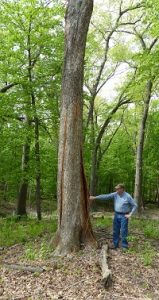
This stately Oak took a full bodies hit that vaporized the sap and blew off the bark in four places.
An enormous explosion brought us bolt upright in bed. 10:44 p.m. just after we’d fallen asleep on April 27th. . The blast was so powerful it knocked pictures off the wall shattering the frames and glass. A quick check revealed no other home damage and a few low rumbles assured us that the noise had been thunder created by a very close lighting strike and not a bomb.
A few days later we discovered a massive white oak about 300 feet from our home with its bark blown off in four different places and loose in others. The lightning’s heat and force vaporized the tree’s sap and enormous pressure blew the bark off. It’s hard to imagine that so much damage could happen in a two tenths of a second-long lightning bolt. The thing is, the tree top is lower than our home! Why did lightning strike there and not the house?
A lightning strike isn’t always a tree’s kiss of death. If only a narrow swath of bark is blown off it may recover. But we fear our magnificent oak was so damaged that its days are numbered.
The tree’s imminent death is good news for small songbirds, especially brown creepers that seek shelter between loose bark and a tree’s trunk. As the oak gradually deteriorates it will provide food and shelter for a host of insects and the woodpeckers that love dining on them. We anticipate a day when our pileated, red headed, red bellied, hairy and downy woodpeckers nest in the old oak snag. Eventually it will topple over and over time return nutrients from rotting wood to the soil.
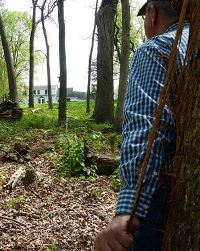
The distance from the lightning strike to the house is about a football field.
Lighting can be both lethal and sneaky. Every year it strikes about 25 million times in the United States and kills an average of 49 people. Many more humans are hit but survive, often with lingering physical problems. Ligntning is nothing to fool around with. As we learned on April 27th sometimes lightning strikes well before the main storm arrives and after it leaves. The safest place to be is inside a building away from windows, pipes, water, wires and landline telephones.
To stay safe, follow the 30-30 rule of thumb. When you first see lightning, begin to count “One Mississippi, two Mississippi….” until you hear thunder. If you hear thunder before you reach the number 30, lightning from the storm is in striking distance. Go inside! And, after the last rumble of thunder wait 30 minutes before venturing outside again.
An outstanding source of information, including many safety tips, is on the US Government’s website.
by Winding Pathways | May 9, 2016 | Birds, Nature
At the end of April house wrens returned to Iowa right on schedule. Every year they seem to appear like magic. Where they were absent just a day or two before the yard suddenly seems to be filled with wren antics and their effervescent voice.
House wrens winter throughout South America and summer across most of North America. Many make their home year round in Mexico.
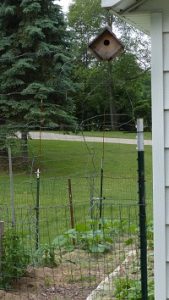
Wrens feast on insects that pillage gardens.
Wrens love suburbia with its diversity of buildings, shrubs, shade trees, and gardens. Soon after arriving in Iowa, a wren pair begins housekeeping. Of all birds house wrens are probably the easiest to lure into a birdhouse. They are not shy. The nest box can be positioned where viewing the emerging family is easy. Wrens also are not fussy. If they can’t find a tree cavity or bird house they’ll move into an old shoe or tin can.
Wrens are tiny birds with enormous appetites. They dine on adult insects, caterpillars, spiders, and many other invertebrates that most people consider pests. A pair nesting near a garden will forage amid vegetables and flowers seeking crop damaging insects.
Perhaps the best wren attributes are their utter cheerfulness and energy. Few wild animals are more fun to watch and listen to. Anyone unfamiliar with the distinctive call of this delightful bird can go to the Cornell Laboratory of Ornithology All About Birds. Type in” house wren” and learn more about this amazing summer Iowan and hear its call.
by Winding Pathways | May 2, 2016 | Birds, Nature
We recently noticed a tiny water drip above our dining room table. It looked like we had a roof leak. Instead of dragging the heavy ladder out to check the roof we grabbed a pair of binoculars that we always keep handy. From the yard the binoculars gave us a close up view of our shingles without the hassle and danger of being on the roof. They looked OK.
We next checked upstairs pipes. Sure enough we found a slight leak that was easy to fix. We were happy we never had to go up on the roof.
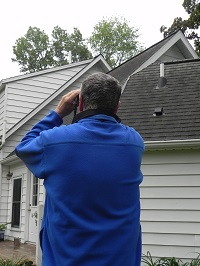
From the yard the binoculars give us a close up view of our shingles without the hassle and danger of being on the roof.
Although many people consider binoculars only useful for wildlife or sports viewing, we find them handy for household inspections. We usually have a pair handy and mostly use them for viewing nature and occasionally when we go to the theater or a ball game.
Binoculars have undergone an amazing boost in quality since grandma bought a pair years ago. Today they are available in all sorts of shapes, sizes and magnifications. Relative to inflation, they are less expensive than those of yesteryear. Unfortunately, with so many types on the market buying the perfect pair can seem complicated. Here’s how we choose ours:
First, know what the numbers mean. Binoculars have two numbers, such as 8X42. The first number indicates its magnification. For example objects will look 8 times closer with an 8 power scope.The second number is the objective lens. It is the diameter of the lens farthest from the eyes.The bigger the number the larger the glass will be and the more light the lens will admit. A high number, such as 8X50 will allow the best viewing in dim light and are excellent for astronomy. The downside is their size. They are large. Ten or twelve power binoculars will bring images closer than 8 power but they have two downsides. The higher the power the harder it is to hold them steady.The image will jiggle a bit. Also, the field of view gets smaller as power increases.Trying to locate a tiny bird in a distant tree grows increasingly difficult as power expands. Some binoculars have an image stabilizer which helps. Read the specifications to learn many details of any pair.
Second, decide what you are going to use them for. Most people are best served with a general purpose pair. Usually this means 8X42. These are perfect for use around the house or carrying in the car. For travel and concerts, tiny 8X20 compact binoculars are about the size of a cell phone and weigh next to nothing. They are a bit less comfortable to use than full size ones but will bring a colorful bird, scenic view or performer up close. Some binoculars are water proof, a plus for anyone using them from a boat or out in the rain. Rich prefers binoculars that focus closely since he often views butterflies or bees on flowers just past his toes. Not all binoculars focus closely.
Third, decide how much money you will spend. We avoid bargain basement binoculars that sell for around $29. They are hard to use and don’t give a good view. They also break easily. On the other extreme are expensive, usually European, binoculars. We’ve never had the cash to buy one of these. Happily, hundreds of excellent binoculars are on the market. They start at around $100 or $125 a pair and range up to around $500. The higher priced ones usually give a brighter image and are clear even toward the edge of the viewing area.
The Binoculars We Use At Winding Pathways
We have several pair of binoculars. Here are the ones we most often use:
Marion prefers 10X32 Alpen Apex around the house and while car touring. These have excellent optics and are relatively small sized. They fit her smallish hands well.
Rich prefers 8X42 Alpen Wings ED for yard and car use. He keeps a pair of Alpen Apex 8X42 in his pickup truck all the time.These are somewhat larger than the pair Marion prefers and fit his large hands well.
Both Rich and Marion carry a pair of Alpen Wings ED in 8X20 when traveling or heading for the ball field or theater. Tiny with excellent optics they easily slip into a purse or jacket pocket.
While we have enjoyed using many other brands of binoculars that provide excellent viewing at reasonable cost, we particularly like Alpen.
by Winding Pathways | Apr 19, 2016 | Labyrinths, Nature, Trees/Shrubs, Wonderment
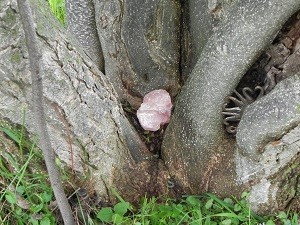
Heart of the tree
A short reflection walking in the Laughing Labyrinth.
by Winding Pathways | Apr 10, 2016 | Geology/Weather, Nature
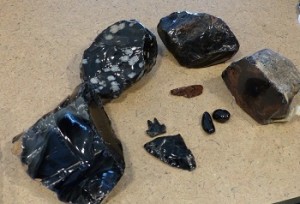
A volcanic glass, Obsidian occurs in volcanic areas such as the western United States.
We’re honored to welcome visitors to our Winding Pathways website seeking information on obsidian. Many have probably learned of this rock through video games.
Ironically Winding Pathways is located in Iowa, a state where natural deposits of obsidian aren’t found. However, the rock was so useful to Native Americans that an extensive trade network existed in North America and it was carried far and wide by prehistoric traders. All Iowa obsidian was carried here by Native Americans and has only been found as artifacts.
Obsidian is an amazing rock. It formed when lava cooled so quickly that the molten rock could not form a crystalline structure. Usually black, obsidian can be of many other colors. It occurs naturally around the world where volcanism occurred relatively recently. Fairly common in western states it has also been found in Pennsylvania, North Carolina and Virginia. A well-known hillside in Yellowstone National Park is composed of this rock. It’s fun to see but collecting is not allowed in national parks.
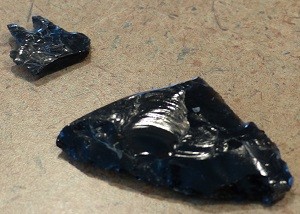
The smaller piece is the back of a point. The larger piece is the broken tip of a point.
Because of its amorphous, or non-crystalline, structure obsidian breaks cleanly creating extremely sharp edges. It’s been used by people for at least 1.5 million years as the raw material that could be crafted into knives, spear points and other sharp tools. Today obsidian is often made into jewelry, and there are reports of ultra-sharp shards of it being used for surgery.
An easy way to see obsidian and hundreds of other types of rocks and minerals is to visit a rock shop. They are common in tourist areas, and we’ve always found visiting them fun. Often the owner is so happy to see a customer that he’ll give a personal tour and share oodles of rock information, even if no money is exchanged.
Another great way to see obsidian……and buy a chunk……..is to visit a rock show. Held around the country they bring rock enthusiasts together to talk, barter, buy and sell. To locate a show near your home check RockNGem and show-dates.
Eastern Iowa’s 2016 Cedar Valley Rock and Mineral Society’s big Gem, Mineral and Fossil Show will be April 16 and 17 at Hawkeye Downs in Cedar Rapids. Programs, demonstrations, pebble pits for kids, gorgeous jewelry, equipment and raw materials all will be featured.
Wherever you live, take in a rock show and rub elbows with rock hounds and lapidists, and invest in some cool rocks and crystals.








